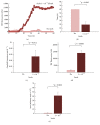Prion Diagnosis: Application of Real-Time Quaking-Induced Conversion
- PMID: 28596963
- PMCID: PMC5449729
- DOI: 10.1155/2017/5413936
Prion Diagnosis: Application of Real-Time Quaking-Induced Conversion
Abstract
Prions composed of pathogenic scrapie prion protein (PrPSc) are infectious pathogens that cause progressive neurological conditions known as prion diseases or transmissible spongiform encephalopathies. Although these diseases pose considerable risk to public health, procedures for early diagnosis have not been established. One of the most recent attempts at sensitive and specific detection of prions is the real-time quaking-induced conversion (RT-QuIC) method, which measures the activity of PrPSc aggregates or amyloid formation triggered by PrPSc seeds in the presence of recombinant PrP. In this review, we summarize prions, prion diseases, and current approaches to diagnosis, including the principle, conditions for assay performance, and current diagnostic applications of RT-QuIC.
Figures

Similar articles
-
Preparation of lyophilized recombinant prion protein for TSE diagnosis by RT-QuIC.BMC Res Notes. 2018 Dec 14;11(1):895. doi: 10.1186/s13104-018-3982-5. BMC Res Notes. 2018. PMID: 30547851 Free PMC article.
-
Detection of Pathognomonic Biomarker PrPSc and the Contribution of Cell Free-Amplification Techniques to the Diagnosis of Prion Diseases.Biomolecules. 2020 Mar 19;10(3):469. doi: 10.3390/biom10030469. Biomolecules. 2020. PMID: 32204429 Free PMC article. Review.
-
PAD-Beads enrichment enhances detection of PrPSc using real-time quaking-induced conversion.BMC Res Notes. 2019 Dec 13;12(1):806. doi: 10.1186/s13104-019-4842-7. BMC Res Notes. 2019. PMID: 31836019 Free PMC article.
-
Rapid and Quantitative Assay of Amyloid-Seeding Activity in Human Brains Affected with Prion Diseases.PLoS One. 2015 Jun 12;10(6):e0126930. doi: 10.1371/journal.pone.0126930. eCollection 2015. PLoS One. 2015. PMID: 26070208 Free PMC article.
-
Applications of the real-time quaking-induced conversion assay in diagnosis, prion strain-typing, drug pre-screening and other amyloidopathies.Expert Rev Mol Diagn. 2017 Oct;17(10):897-904. doi: 10.1080/14737159.2017.1368389. Epub 2017 Sep 8. Expert Rev Mol Diagn. 2017. PMID: 28817974 Review.
Cited by
-
Role of donor genotype in RT-QuIC seeding activity of chronic wasting disease prions using human and bank vole substrates.PLoS One. 2020 Jan 7;15(1):e0227487. doi: 10.1371/journal.pone.0227487. eCollection 2020. PLoS One. 2020. PMID: 31910440 Free PMC article.
-
Real-time Quaking-induced Conversion Assay for the Diagnosis of Sporadic Creutzfeldt-Jakob Disease in a Living Patient.Infect Dis (Auckl). 2019 Sep 9;12:1178633719874797. doi: 10.1177/1178633719874797. eCollection 2019. Infect Dis (Auckl). 2019. PMID: 31534344 Free PMC article.
-
Detection of prions in matching post-mortem skin and cerebrospinal fluid samples using second-generation real-time quaking-induced conversion assay.Sci Rep. 2024 Mar 15;14(1):6294. doi: 10.1038/s41598-024-56789-6. Sci Rep. 2024. PMID: 38491063 Free PMC article.
-
Direct Observation of Murine Prion Protein Replication in Vitro.J Am Chem Soc. 2018 Nov 7;140(44):14789-14798. doi: 10.1021/jacs.8b08311. Epub 2018 Oct 23. J Am Chem Soc. 2018. PMID: 30351023 Free PMC article.
-
A Case of a Patient Who Presented with Rapidly Progressive Dementia and Capricious RT-QuIC Results.Dement Neurocogn Disord. 2020 Mar;19(1):36-38. doi: 10.12779/dnd.2020.19.1.36. Epub 2020 Mar 16. Dement Neurocogn Disord. 2020. PMID: 32174052 Free PMC article. No abstract available.
References
Publication types
MeSH terms
Substances
LinkOut - more resources
Full Text Sources
Other Literature Sources
Research Materials

